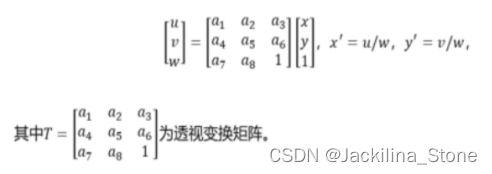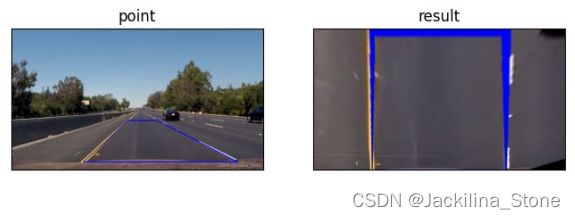数字图像处理(入门篇)十四 透视变换
目录
一 透视变换
二 实践
(1)代码
(2)结果图
一 透视变换
现实生活中的空间是三维的,图像中的物体存在近大远小的特征,这种畸变仿射变换不能矫正。因此,我们需要使用到三维空间的变化,就是透视变换。透视变换(Perspective Transformation)的本质是将图像投影到一个新的视平面。
透视变换是非线性变换。透视变换公式如下:
从上述公式可知,变换矩阵有8个参数,因此要确定4个像素点变换前后的对应坐标才能够求出透视变换矩阵。
二 实践
(1)代码
import cv2
import matplotlib.pyplot as plt
import numpy as np
# 获取透视变换的参数矩阵
def cal_perspective_params(img, points):
offset_x = 300
offset_y = 0
img_size = (img.shape[1], img.shape[0])
src = np.float32(points)
# 设置俯视图中的对应的四个点
dst = np.float32([[offset_x, offset_y], [img_size[0] - offset_x, offset_y],
[offset_x, img_size[1] - offset_y], [img_size[0] - offset_x, img_size[1] - offset_y]])
# 原图像转换到俯视图
M = cv2.getPerspectiveTransform(src, dst)
# 俯视图到原图像
M_inverse = cv2.getPerspectiveTransform(dst, src)
return M, M_inverse
def img_perspect_transform(img, M):
# 根据参数矩阵完成透视变换
img_size = (img.shape[1], img.shape[0])
return cv2.warpPerspective(img, M, img_size)
def dealImageResult(img_path):
img = cv2.imread(img_path)
img = cv2.cvtColor(img, cv2.COLOR_BGR2RGB)
# 几个点是人工选择的,根据情况自己调整
left_up = [595, 470]
right_up = [740, 470]
left_down = [365, 680]
right_down = [1150, 680]
points = [left_up, right_up, left_down, right_down]
img = cv2.line(img, left_up, right_up, (0, 0, 255), 3)
img = cv2.line(img, right_up, right_down, (0, 0, 255), 3)
img = cv2.line(img, left_up, left_down, (0, 0, 255), 3)
img = cv2.line(img, left_down, right_down, (0, 0, 255), 3)
M, M_inverse = cal_perspective_params(img, points)
# 这里只针对透视变化功能,相机去畸变的功能跳过
trasform_img = img_perspect_transform(img, M)
fig = plt.figure(figsize=(8, 8))
titles = ["point", "result"]
images = [img, trasform_img]
for i in range(2):
plt.subplot(1, 2, i + 1), plt.imshow(images[i], 'gray')
plt.title(titles[i])
plt.xticks([]), plt.yticks([])
plt.show()
fig.savefig('test_results.jpg', bbox_inches='tight')
if __name__ == '__main__':
dealImageResult("test.png")
pass(2)结果图

